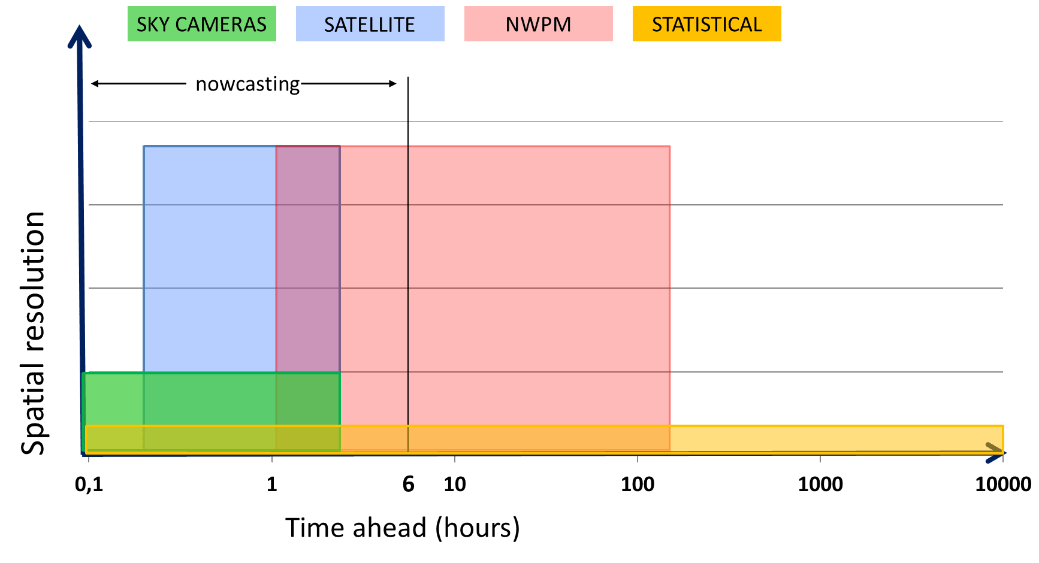Introduction
CSP is dominated by large power plants, resulting in needs for forecasting at the site of the power plant (Schroedter-Homscheidt & Wilbert, 2017). Therefore, a point forecast for the power plant location is needed. The power plant operator may need as well as spatially resolved forecast inside the solar field of a power plant. The grid operator may need a number of forecasts for all CSP power plants inside the grid operation zone (e.g. a region, a country, a multi-country area).
In general, several forecast horizons are needed – from nowcasting of the upcoming minutes to hours up to forecasting of today or the upcoming 10 days.
Even when some different methodologies are used commonly for its ensemble in an unique prediction, the basis of the weather forecasting is the use of numerical weather prediction (NWP) models (Perez et al., 2011).

(H) Education
In case of e.g. grid integration studies in the training sector, forecast data is requested to quantify the value of the market participation in the economic feasibility calculation with respect to local forecast quality. In this case, historical forecasts of a previous year will be used.
The relevant features for the solar radiation forecasting and nowcasting for this application are the following:
- Temporal resolution: 15 to 60 min (depending on market).
- Forecasting horizon: NWP-based short-term forecasts for the upcoming day.
- Refresh time: updated every 6 or 3 hours.
- Spatial resolution: point forecast for the center of the power plant solar field.
- Variables: DNI, uncertainty ranges, expected variability.
| Users | ||||||||
| Proyect developers needs at diferent plant stages | Other users | |||||||
| Category of product service | (A) Pre-feasibility | (B) Feasibility & Design | (C) Due Diligence Financing | (D) Plant Accep-tance Test | (E) Systems or Plant Operations | (F) Grid operators | (G) Policy makers | (H) Education / Outreach |
| SOLAR RADIATION FORECASTING AND NOWCASTING | ❌ | ✅ | ✅ | ✅ | ✅ | ✅ | ✅ | ✅ |
|---|---|---|---|---|---|---|---|---|
Solar Radiation Forecasts in different time horizons
- Temporal resolution
DNI values in NWP forecasts represent an accumulated value over a certain time interval. The temporal resolution defines the length of these intervals. In camera- and satellite-based forecasts both can be available – accumulated values or instantaneous radiation values for a certain point in time.
For wind speed NWP models provide instantaneous value at the reported time which is typically validated against observations providing the mean of the last 10 minutes before the reported time. Furthermore, NWP models provide maximum winds over a defined period (e.g. 1h, 6h, or 12h) and provide wind gusts as maximum value during the previous period. Based on ensemble forecasts, also the probability to exceed 15 or 20 m/s wind gusts is available as well and may serve as useful to predict potential storm damage.
- Forecasting horizon
The forecast horizon is the number of minutes, hours, or days up to which a forecasting system delivers forecasts.
- Refresh time
This is defined as the frequency the forecast system is started again and the forecasted values are updated. It may be several hours in NWP-based forecasts and less than a minute for nowcasts.
- Spatial resolution
From one single point for the power plant to the spatially resolved DNI inside the solar field on sub-field sector level.
- Variables
DNI, wind gust, air temperature, uncertainty ranges, circumsolar ratio/sun shape, expected variability, aerosol load in the boundary layer.

